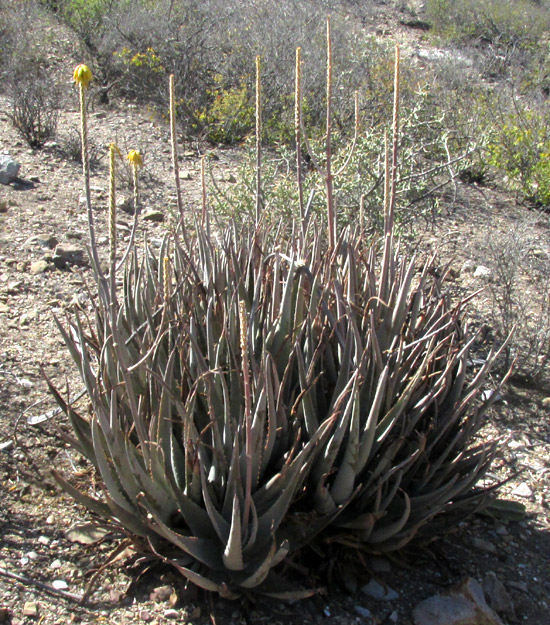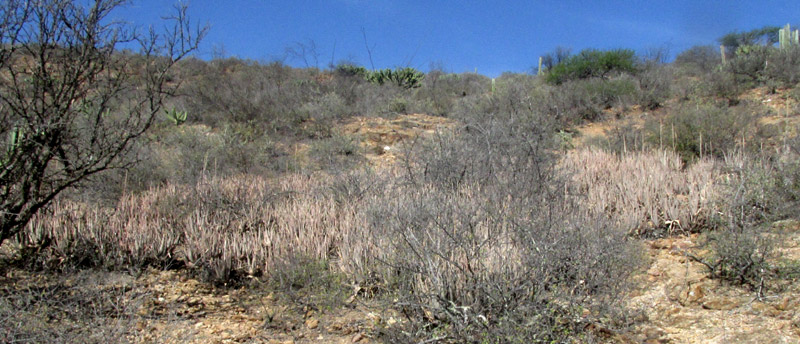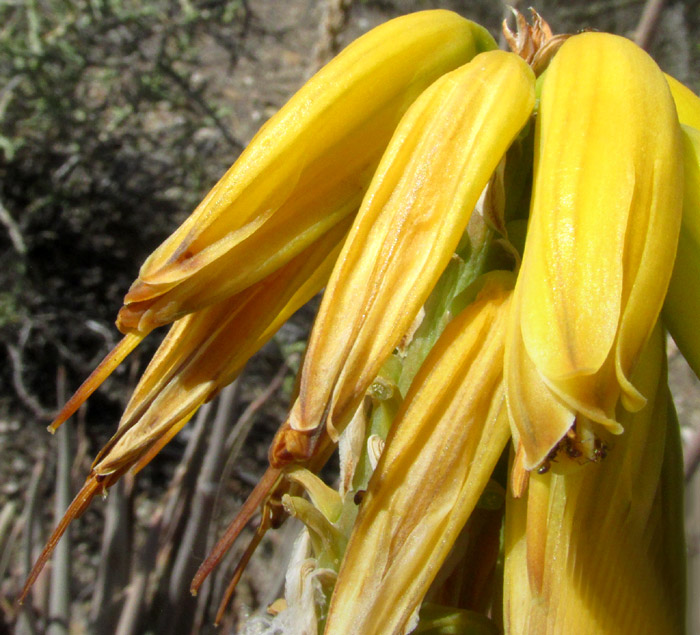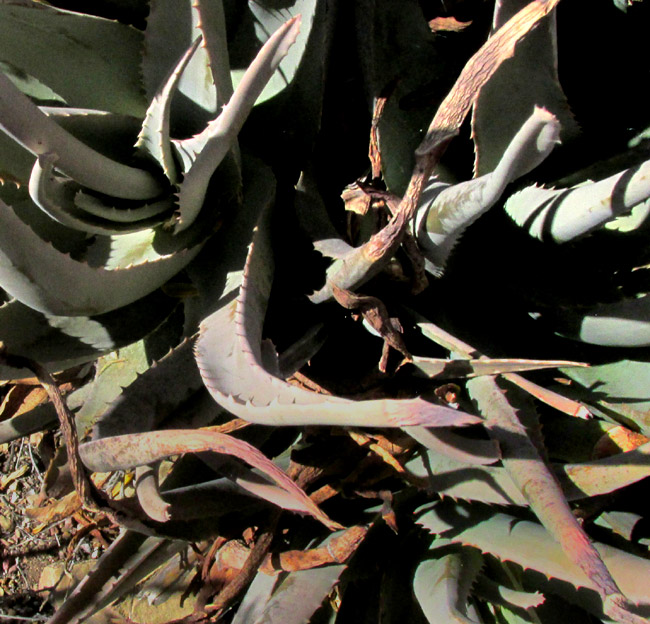Excerpts from Jim Conrad's
Naturalist Newsletter
Entry dated March 7, 2024, from notes taken about 2kms south of Higuerillas, Municipality of Cadereyta de Montes; N20.8872°, W99.7718°, elevation ~1660 meters (~5450 feet); rocky soil derived from bedrock of limestone and limy mudstone; local narrow belt of vegetation constituting an extreme southern extension of the Chihuahuan Desert, Meridional Subregion; central Querétaro state, MÉXICO
ALOE VERA AS AN INVASIVE

The above clustering, rosette-forming, succulent plant was one of very few species flowering during this continuing, 2½-year period the North American Drought Monitor classifies as a D3 Extreme Drought. On the opposite slope, the extensive population shown below formed a dense thicket amid surrounding shrubs which were dry-season leafless:

A closer look at the flowers and the branching stems on which the blossoms had fallen away revealed the plants' identity:

It was ALOE VERA, the same Aloe vera my grandma Conrad grew as a very different looking potted houseplant because its leaves stayed green all winter long. Later, also I grew it, calling it Burn Plant; I'd smear gelatinous sap from inside its leaves onto burns to keep them from blistering and being sore. Even later, I became accustomed to seeing it in many tropical countries around houses and in town, grown as ornamental plants. Often I've seen relict Aloe Vera plants growing where once they'd been planted, then abandoned -- maybe now with trees grown up around them -- but in this area the plants grew where surely no one had ever planted them; they'd "gone wild" after being introduced from the Old World.

Up close, the typical Aloe Vera flowers displayed six yellow tepals -- tepals the term used when petals and calyx lobes are indistinguishable -- which were variously fused together at their bases, and of varying lengths. Notice how the slender, stigma-topped styles usually extend well beyond the tepals' tips. At the mouth of the freshest blossom, on the picture's right side, tiny, black ants are visible. Nearly all of the freshest blossoms sheltered numerous ants. I saw no lines of ants streaming up and down the stems, so it appeared that the ants were sheltering in the flowers.

A dissected flower showed six stamens with slender filaments of slightly different lengths, but without anthers. You can compare the above picture with a similarly open blossom with intact stamens and no ants. I'm guessing that in the above picture ants have eaten the pollen-laden anthers. Probably the white flakes littering the flower's interior are the anthers' remains. Also, notice the strange bumps on the filaments. Gardeners know that if your succulents have ants among them, usually it's because the ants are "farming" aphids or mealybugs -- carrying them from place to place and protecting them in exchange for the sweet nectar the farmed insects produce. I'm guessing that the evenly spaced bumps on the filaments are eggs of a farmed insect not visible in the picture; they could be aphid eggs.

The succulent leaves of these plants were covered with a silvery or "glaucescent" substance which easily rubbed off, and the margins' spines were harder and better developed than on potted Aloe Veras in a window. Notice how some leaves have withered up, apparently in response to the drought.
Aloe Vera is described by CABI, the Centre for Agriculture and Bioscience International, as spreading both vegetatively by suckers and by seeds, and that the likelihood of new introductions of Aloe Vera into the landscape is very high. The Flora del Bajío, which documents plant occurrences in this part of highland central Mexico, reports that the species frequently is observed in the uplands along roadsides and streams. It also says that everything seems to indicate that in our area fruits are never formed. It's true that ovaries on our photographed plants were being aborted, but I thought that might be because of the drought. Surely nobody ever planted the ones I was seeing in such scattered, hard to reach places. Maybe the area's many wandering, feral burros somehow moved the stolons about.
Aloe Vera's native land is uncertain, but consensus is that it's from the Arabian Peninsula, maybe Oman. The 2021 study by Shubham Jaiswal and others entitled "The genome sequence of Aloe vera reveals adaptive evolution of drought tolerance mechanisms," found several ways Aloe vera has been able to adapt so effectively to so many different environmental conditions, including my grandmother's windowsill. As the species was spread across the Earth by humans, several of its genes encouraged adaptive evolution affecting drought stress response, the species' CAM photosynthesis pathway, its circadian rhythm responses, and its cells' DNA repair ability.
Despite Aloe Vera being an introduced plant in Mexico, the online Atlas de las Plantas de la Medicina Tradicional Mexicana, which refers to Aloe vera by the name of sábila, mentions that already in the 1500s Sahagún's Florentine Codex advised grinding up the plant's root for application as a poultice over broken bones. During the same century, it was recommended for the skin disease erysipelas. In the 1700s juice from the plant was used to combat ear worms (!) and intestinal worms. More recently documented traditional uses are too many to list, though the main ones appear to be as a laxative, diuretic, and to encourage wounds to heal.